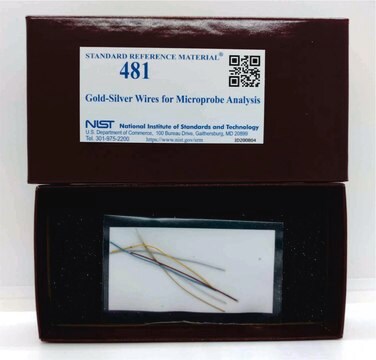349283
Gold
wire, diam. 0.1 mm, 99.99% trace metals basis
Synonym(s):
Gold Powder, Gold black, Gold element
Sign Into View Organizational & Contract Pricing
All Photos(1)
About This Item
Empirical Formula (Hill Notation):
Au
CAS Number:
Molecular Weight:
196.97
EC Number:
MDL number:
UNSPSC Code:
12141717
PubChem Substance ID:
NACRES:
NA.23
Recommended Products
Assay
99.99% trace metals basis
form
wire
resistivity
2.05 μΩ-cm, 0°C
diam.
0.1 mm
bp
2808 °C (lit.)
mp
1063 °C (lit.)
density
19.3 g/mL at 25 °C (lit.)
SMILES string
[Au]
InChI
1S/Au
InChI key
PCHJSUWPFVWCPO-UHFFFAOYSA-N
Application
Gold wires can be used for a variety of applications such as a probe for tip enhanced near-field optical microscopy (TENOM) which can further be used in the detection of fluorescence or Raman emission and as a probe that facilitates the electrical conductivity of the metallic composites.
Quantity
150 mg = 1 m; 750 mg = 5 m
Storage Class Code
11 - Combustible Solids
WGK
nwg
Flash Point(F)
Not applicable
Flash Point(C)
Not applicable
Personal Protective Equipment
dust mask type N95 (US), Eyeshields, Gloves
Choose from one of the most recent versions:
Already Own This Product?
Find documentation for the products that you have recently purchased in the Document Library.
Stretchable gold conductors on elastomeric substrates
Lacour S, et al.
Applied Physics Letters, 82(15), 2404-2406 (2003)
Apertureless near-field/far-field CW two-photon microscope for biological and material imaging and spectroscopic applications
Nowak DB, et al.
Applied Optics, 49(35), 6766-6771 (2010)
Enhanced image contrast with delocalized near-field excitation
Sanchez E, et al.
Crystal Research and Technology, 49(9), 681-689 (2014)
Tianxun Gong et al.
Journal of biomedical nanotechnology, 9(6), 985-991 (2013-07-19)
In this paper, we proposed the use of gold nanoparticles as plasmon scattering probes for dark-field multiplex imaging of live cancer cells. By carefully engineering the surfaces, aqueous dispersions of anti-EGFR antibody-conjugated gold nanospheres and gold nanorods are prepared. We
Tae-Sik Cho et al.
Journal of nanoscience and nanotechnology, 13(5), 3711-3714 (2013-07-19)
The crystallization of Au/glass ultrathin films for surface plasmon resonance (SPR) biosensor has been studied using synchrotron X-ray scattering and field emission scanning electron microscope. In films thinner than 30 nm, crystallized Au grains with [111] preferred orientation were formed
Our team of scientists has experience in all areas of research including Life Science, Material Science, Chemical Synthesis, Chromatography, Analytical and many others.
Contact Technical Service




